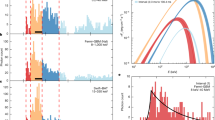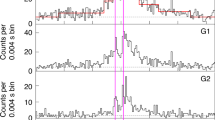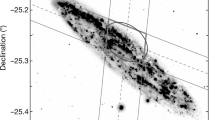Abstract
Magnetars are the most highly magnetized neutron stars in the cosmos (with magnetic field 1013–1015 G). Giant flares from magnetars are rare, short-duration (about 0.1 s) bursts of hard X-rays and soft γ rays1,2. Owing to the limited sensitivity and energy coverage of previous telescopes, no magnetar giant flare has been detected at gigaelectronvolt (GeV) energies. Here, we report the discovery of GeV emission from a magnetar giant flare on 15 April 2020 (refs. 3,4 and A. J. Castro-Tirado et al., manuscript in preparation). The Large Area Telescope (LAT) on board the Fermi Gamma-ray Space Telescope detected GeV γ rays from 19 s until 284 s after the initial detection of a signal in the megaelectronvolt (MeV) band. Our analysis shows that these γ rays are spatially associated with the nearby (3.5 megaparsecs) Sculptor galaxy and are unlikely to originate from a cosmological γ-ray burst. Thus, we infer that the γ rays originated with the magnetar giant flare in Sculptor. We suggest that the GeV signal is generated by an ultra-relativistic outflow that first radiates the prompt MeV-band photons, and then deposits its energy far from the stellar magnetosphere. After a propagation delay, the outflow interacts with environmental gas and produces shock waves that accelerate electrons to very high energies; these electrons then emit GeV γ rays as optically thin synchrotron radiation. This observation implies that a relativistic outflow is associated with the magnetar giant flare, and suggests the possibility that magnetars can power some short γ-ray bursts.
This is a preview of subscription content, access via your institution
Access options
Access Nature and 54 other Nature Portfolio journals
Get Nature+, our best-value online-access subscription
$29.99 / 30 days
cancel any time
Subscribe to this journal
Receive 12 digital issues and online access to articles
$119.00 per year
only $9.92 per issue
Buy this article
- Purchase on Springer Link
- Instant access to full article PDF
Prices may be subject to local taxes which are calculated during checkout

Similar content being viewed by others
Data availability
The Fermi-LAT data are publicly available at the Fermi Science Support Center website: https://fermi.gsfc.nasa.gov/ssc/. Filtered data supporting the findings of this study are available at https://www-glast.stanford.edu/pub_data/1801/.
Code availability
In this study we use the Fermi-LAT Science Tools, publicly available at the Fermi Science Support Center website: https://fermi.gsfc.nasa.gov/ssc/. The code required to reproduce each figure of the paper is available from the corresponding authors upon request.
References
Frail, D. A., Kulkarni, S. R. & Bloom, J. S. An outburst of relativistic particles from the soft γ-ray repeater SGR1900+14. Nature 398, 127–129 (1999).
Hurley, K. et al. An exceptionally bright flare from SGR 1806-20 and the origins of short-duration γ-ray bursts. Nature 434, 1098–1103 (2005).
Svinkin, D. & the IPN Team. Bright twin γ-ray flares in two nearby galaxies as giant magnetar flares. Nature https://doi.org/10.1038/s41586-020-03076-9 (2021).
Roberts, O. J. & the GBM and Swift Teams. Rapid spectral variability of a giant flare from an extragalactic magnetar. Nature https://doi.org/10.1038/s41586-020-03077-8 (2021).
Rekola, R. et al. Distance to NGC 253 based on the planetary nebula luminosity function. Mon. Not. R. Astron. Soc. 361, 330–336 (2005).
Frederiks, D. D. et al. On the possibility of identifying the short hard burst GRB 051103 with a giant flare from a soft gamma repeater in the M81 group of galaxies. Astron. Lett. 33, 19–24 (2007).
Mazets, E. P. et al. A giant flare from a soft gamma repeater in the Andromeda galaxy (M31). Astrophys. J. 680, 545–549 (2008).
VizieR Online Data Catalog NGC 2000.0 VII/118 (Sky Publishing, 1988); http://go.nature.com/3bsaO6o
Abdollahi, S. et al. Fermi Large Area Telescope fourth source catalog. Astrophys. J. Suppl. 247, 33 (2020).
Ackermann, M. et al. GeV observations of star-forming galaxies with the Fermi Large Area Telescope. Astrophys. J. 755, 164 (2012).
de Ruiter, H. R., Willis, A. G. & Arp, H. C. A Westerbork 1415 MHz survey of background radio sources. II. Optical identifications with deep IIIa-J plates. Astron. Astrophys. Suppl. 28, 211–293 (1977).
Li, T. P. & Ma, Y. Q. Analysis methods for results in gamma-ray astronomy. Astrophys. J. 272, 317–324 (1983).
Scargle, J. D. Studies in astronomical time series analysis. V. Bayesian blocks, a new method to analyze structure in photon counting data. Astrophys. J. 504, 405 (1998).
Scargle, J. D., Norris, J. P., Jackson, B. & Chiang, J. Studies in astronomical time series analysis. VI. Bayesian block representations. Astrophys. J. 764, 167 (2013).
Story, S. A. & Baring, M. G. Magnetic pair creation transparency in gamma-ray pulsars. Astrophys. J. 790, 61 (2014).
Thompson, C. & Duncan, R. C. The soft gamma repeaters as very strongly magnetized neutron stars—I. Radiative mechanism for outbursts. Mon. Not. R. Astron. Soc. 275, 255–300 (1995).
Lyutikov, M. Mass-loading of pulsar winds. Mon. Not. R. Astron. Soc. 339, 623–632 (2003).
Gill, R. & Heyl, J. S. On the trigger mechanisms for soft gamma-ray repeater giant flares. Mon. Not. R. Astron. Soc. 407, 1926–1932 (2010).
Ioka, K., Razzaque, S., Kobayashi, S. & Mészáros, P. TeV-PeV neutrinos from giant flares of magnetars and the case of SGR 1806-20. Astrophys. J. 633, 1013–1017 (2005).
Nakar, E., Piran, T. & Sari, R. Pure and loaded fireballs in soft gamma-ray repeater giant flares. Astrophys. J. 635, 516–521 (2005).
Gelfand, J. D. et al. A rebrightening of the radio nebula associated with the 2004 December 27 giant flare from SGR 1806-20. Astrophys. J. Lett. 634, L89–L92 (2005).
Granot, J. et al. Diagnosing the outflow from the SGR 1806-20 giant flare with radio observations. Astrophys. J. 638, 391–396 (2006).
Cheng, K. S. & Wang, X. Y. The radio afterglow from the giant flare of SGR 1900+14: the same mechanism as afterglows from classic gamma-ray bursts? Astrophys. J. Lett. 593, L85–L88 (2003).
Hurley, K. The short gamma-ray burst—SGR giant flare connection. Adv. Space Res. 47, 1337–1340 (2011).
Abdo, A. A. et al. Search for gamma-ray emission from magnetars with the Fermi Large Area Telescope. Astrophys. J. Lett. 725, L73–L78 (2010).
Li, J., Rea, N., Torres, D. F. & de Oña-Wilhelmi, E. Gamma-ray upper limits on magnetars with six years of Fermi-LAT observations. Astrophys. J. 835, 30 (2017).
Ajello, M. et al. A decade of gamma-ray bursts observed by Fermi-LAT: the second GRB catalog. Astrophys. J. 878, 52 (2019).
Atwood, W. B. et al. The Large Area Telescope on the Fermi Gamma-Ray Space Telescope Mission. Astrophys. J. 697, 1071–1102 (2009).
Meegan, C. et al. The Fermi Gamma-ray Burst Monitor. Astrophys. J. 702, 791 (2009).
Bissaldi, E. et al. GRB 200415A: Fermi GBM observation. GRB Coord. Netw. No. 27587 (2020).
Mattox, J. R. et al. The likelihood analysis of EGRET data. Astrophys. J. 461, 396 (1996).
Omodei, N. et al. GRB 200415A: Fermi-LAT localization update. GRB Coord. Netw. No. 27597 (2020).
Ackermann, M. et al. The first Fermi-LAT gamma-ray burst catalog. Astrophys. J. Suppl. 209, 11 (2013).
Abdo, A. A. et al. The on-orbit calibration of the Fermi Large Area Telescope. Astropart. Phys. 32, 193–219 (2009).
Atwood, W. et al. Pass 8: toward the full realization of the Fermi-LAT scientific potential. Preprint at https://arxiv.org/abs/1303.3514 (2013).
Sutherland, W. & Saunders, W. On the likelihood ratio for source identification. Mon. Not. R. Astron. Soc. 259, 413–420 (1992).
Masci, F. J. et al. A new complete sample of submillijansky radio sources: an optical and near-infrared study. Publ. Astron. Soc. Pac. 113, 10–28 (2001).
Ciliegi, P. et al. A deep VLA survey at 6 cm in the Lockman Hole. Astron. Astrophys. 398, 901–918 (2003).
Ackermann, M. et al. The second catalog of active galactic nuclei detected by the Fermi Large Area Telescope. Astrophys. J. 743, 171 (2011).
Ackermann, M. et al. The first Fermi-LAT catalog of sources above 10 GeV. Astrophys. J. Suppl. 209, 34 (2013).
McAlpine, K., Jarvis, M. J. & Bonfield, D. G. Evolution of faint radio sources in the VIDEO-XMM3 field. Mon. Not. R. Astron. Soc. 436, 1084–1095 (2013).
Ackermann, M. et al. The third catalog of active galactic nuclei detected by the Fermi Large Area Telescope. Astrophys. J. 810, 14 (2015).
Ajello, M. et al. The fourth catalog of active galactic nuclei detected by the Fermi Large Area Telescope. Astrophys. J. 892, 105 (2020).
de Menezes, R., D’Abrusco, R., Massaro, F., Gasparrini, D. & Nemmen, R. On the physical association of Fermi-LAT blazars with their low-energy counterparts. Astrophys. J. Suppl. 248, 23 (2020).
von Kienlin, A. et al. The fourth Fermi-GBM gamma-ray burst catalog: a decade of data. Astrophys. J. 893, 46 (2020).
Hurley, K. et al. IPN triangulation of GRB 160702A (short/hard). GRB Coord. Netw. No. 19666 (2016).
Kaspi, V. M. & Beloborodov, A. M. Magnetars. Annu. Rev. Astron. Astrophys. 55, 261–301 (2017).
Paczynski, B. Gamma-ray bursters at cosmological distances. Astrophys. J. Lett. 308, L43–L46 (1986).
Goodman, J. Are gamma-ray bursts optically thick? Astrophys. J. Lett. 308, L47 (1986).
Sari, R. & Piran, T. Hydrodynamic timescales and temporal structure of gamma-ray bursts. Astrophys. J. Lett. 455, 143 (1995).
Razzaque, S., Dermer, C. D. & Finke, J. D. Synchrotron radiation from ultra-high energy protons and the Fermi observations of GRB 080916C. Open Astron. J. 3, 150–155 (2010).
De Jager, O. et al. Gamma-ray observations of the Crab nebula: a study of the synchro-compton spectrum. Astrophys. J. 457, 253 (1996).
Acknowledgements
The Fermi-LAT Collaboration acknowledges support for LAT development, operation and data analysis from NASA and the Department of Energy (United States), CEA/Irfu and IN2P3/CNRS (France), ASI and INFN (Italy), MEXT, KEK and JAXA (Japan), and the K. A. Wallenberg Foundation, the Swedish Research Council and the National Space Board (Sweden). Science analysis support in the operations phase from INAF (Italy) and CNES (France) is also gratefully acknowledged. This work was performed in part under Department of Energy contract DE-AC02-76SF00515. E. Burns is a NASA Postdoctoral Program Fellow.
Author information
Authors and Affiliations
Consortia
Contributions
The Fermi-LAT was designed and constructed by the Fermi-LAT Collaboration. The operation, data processing, calibration, Monte Carlo simulations of the detector and of theoretical models, and data analyses were performed by the members of the Fermi-LAT Collaboration. All Fermi-LAT collaborators that signed this paper contributed to the editing of and comments on the final version of the manuscript. A.B., N. Di Lalla, N.O. and F.P. contributed to the analysis and the writing of the manuscript and S. Razzaque provided the interpretation and contributed to the writing of the paper.
Corresponding authors
Ethics declarations
Competing interests
The authors declare no competing financial interests.
Additional information
Peer review information Nature Astronomy thanks the anonymous reviewers for their contribution to the peer review of this work.
Publisher’s note Springer Nature remains neutral with regard to jurisdictional claims in published maps and institutional affiliations.
Extended data
Extended Data Fig. 1 Best-fit parameters from the LAT unbinned likelihood analysis.
All fluxes are calculated in the 100 MeV to 10 GeV energy range.
Extended Data Fig. 2 List of selected events.
We highlight those with high probability (>90%) to be associated with the LAT-detected source, according to the likelihood analysis. The uncertainty on the estimated γ-ray energies is of the order of 10%. The last two columns show the angular distance to the centre of NGC 253 (the Sculptor galaxy) and the 68% containment radius of the PSF.
Extended Data Fig. 3 Distribution of likelihood ratio (LR) values.
LR values for 105 simulated ROIs using the standard Rayleigh formula (a) and using the TS map to compute the probability (b). The red distributions correspond to the point source hypothesis, while the blue distributions take into account of the galaxy extension. The step in the distributions at low LR is due to many low-LR trials occupying the first bin. The values of the LRs associated with the Sculptor galaxy are highlighted by red and blue vertical dashed lines for the two cases.
Extended Data Fig. 4 Association probability and false alarm rate.
Summary of the probability for a random association with the Sculptor galaxy and with the GRB 200415A.
Extended Data Fig. 5 Triplet distribution.
Distribution of the time intervals Δt for triplets formed by three consecutive photons with (green) and without (dashed red) taking into account the correction for the effects of the LAT orbit and FOV. The expected distribution in case of independent events is represented as a solid black line. The vertical line in blue shows the period of the Fermi orbit (5,790 s), while the yellow vertical line indicates Δt = 264.87 s corresponding to the photon triplet detected by the LAT after GBM detected emission from GRB 200415A.
Extended Data Fig. 6 Rate and exposure as a function of time.
Bayesian blocks representation of the arrival times of the γ rays with the prior parameter p = 3 (red). Light green and dark gray are the daily and weekly count rates, while the blue curve shows the weekly-averaged exposure (between 100 MeV and 300 GeV, assuming a power-law photon index of −2) for a 1°-radius ROI in the direction of Sculptor for the entire time of the mission. Values of the exposure, in units of 108 cm2 s, can be read from the right y-axis. The three yellow bands highlight three characteristic observing profiles: 35° rocking angle, at the beginning of the mission, an observation strategy favouring the Galactic Centre region, in the middle, and, lastly, the period between the start of the solar drive anomaly and the implementation of a reoptimized survey strategy.
Extended Data Fig. 7 Comparison with the second Fermi-LAT GRB catalogue.
a, Onset times (TLAT,0 ) in the 100 MeV–100 GeV band versus the end of the GRB as detected by GBM in the 50–300 keV energy range (TGBM,95 ). b, Durations (TLAT,100 ) calculated in the 100 MeV–100 GeV energy range versus the same quantities calculated in the 50–300 keV energy range (TGBM,90 ). The solid line denotes where the two values are equal. Empty Blue and filled red circles represent long and short GRBs, respectively (data from 2FLGC27]). GRB 200415A is added and marked with a yellow star. The two SGRBs 160702A and GRB 170127C from 2FLGC, which exhibit similar durations, are highlighted with a magenta circle and green square, respectively.
Rights and permissions
About this article
Cite this article
The Fermi-LAT Collaboration. High-energy emission from a magnetar giant flare in the Sculptor galaxy. Nat Astron 5, 385–391 (2021). https://doi.org/10.1038/s41550-020-01287-8
Received:
Accepted:
Published:
Issue Date:
DOI: https://doi.org/10.1038/s41550-020-01287-8



